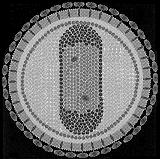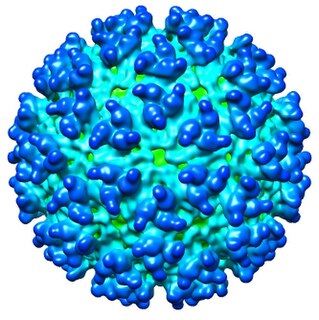Malware is any software intentionally designed to cause damage to a computer, server, client, or computer network. Malware does the damage after it is implanted or introduced in some way into a target's computer and can take the form of executable code, scripts, active content, and other software. The code is described as computer viruses, worms, Trojan horses, ransomware, spyware, adware, and scareware, among other terms. Malware has a malicious intent, acting against the interest of the computer user—and so does not include software that causes unintentional harm due to some deficiency, which is typically described as a software bug.
In computing, a Trojan horse, or Trojan, is any malicious computer program which misleads users of its true intent. The term is derived from the Ancient Greek story of the deceptive wooden horse that led to the fall of the city of Troy.
This timeline of computer viruses and worms presents a chronological timeline of noteworthy computer viruses, computer worms, Trojan horses, similar malware, related research and events.

Henipavirus is a genus of RNA viruses in the family Paramyxoviridae, order Mononegavirales containing five established species. Henipaviruses are naturally harboured by pteropid fruit bats and microbats of several species. Henipaviruses are characterised by long genomes and a wide host range. Their recent emergence as zoonotic pathogens capable of causing illness and death in domestic animals and humans is a cause of concern.
The compilation of a unified list of computer viruses is made difficult because of naming. To aid the fight against computer viruses and other types of malicious software, many security advisory organizations and developers of anti-virus software compile and publish lists of viruses. When a new virus appears, the rush begins to identify and understand it as well as develop appropriate counter-measures to stop its propagation. Along the way, a name is attached to the virus. As the developers of anti-virus software compete partly based on how quickly they react to the new threat, they usually study and name the viruses independently. By the time the virus is identified, many names denote the same virus.

Norton AntiVirus is an anti-virus and anti-malware software package developed and distributed by Symantec Corporation since 1991 as part of its Norton family of computer security products. It uses signatures and heuristics to identify viruses. Other features included in it are e-mail spam filtering and phishing protection.

Max Theiler was a South African-American virologist and physician. He was awarded the Nobel Prize in Physiology or Medicine in 1951 for developing a vaccine against yellow fever in 1937, becoming the first African-born Nobel laureate.

Thomas Huckle Weller was an American virologist. He, John Franklin Enders and Frederick Chapman Robbins were awarded a Nobel Prize in Physiology or Medicine in 1954 for showing how to cultivate poliomyelitis viruses in a test tube, using a combination of human embryonic skin and muscle tissue.
Togaviridae is a family of viruses. Humans, mammals, birds, and mosquitoes serve as natural hosts. There are currently 32 species in this family, divided among 2 genera. Diseases associated with this family include: Alphaviruses: arthritis, encephalitis; Rubiviruses: rubella.

Equine infectious anemia or equine infectious anaemia (EIA), also known by horsemen as swamp fever, is a horse disease caused by a retrovirus and transmitted by bloodsucking insects. The virus (EIAV) is endemic in the Americas, parts of Europe, the Middle and Far East, Russia, and South Africa. The virus is a lentivirus, like human immunodeficiency virus (HIV). Like HIV, EIA can be transmitted through blood, milk, and body secretions.
Transmission is primarily through biting flies, such as the horse-fly and deer-fly. The virus survives up to 4 hours in the vector. Contaminated surgical equipment and recycled needles and syringes, and bits can transmit the disease. Mares can transmit the disease to their foals via the placenta.
The risk of transmitting the disease is greatest when an infected horse is ill, as the blood levels of the virus are then highest.
Eastern equine encephalitis (EEE), commonly called Triple E or, sleeping sickness is a zoonotic alphavirus and arbovirus present in North, Central, and South America and the Caribbean. EEE was first recognized in Massachusetts, United States, in 1831 when 75 horses died mysteriously of viral encephalitis.
Epizootics in horses have continued to occur regularly in the United States. It can also be identified in asses and zebras. Due to the rarity of the disease, its occurrence can cause economic impact in relation to the loss of horses and poultry. EEE is found today in the eastern part of the United States and is often associated with coastal plains. It can most commonly be found in East and Gulf coast states. In Florida, about one to two human cases are reported a year, although over 60 cases of equine encephalitis are reported. Some years in which conditions are favorable for the disease, the number of equine cases is over 200. Diagnosing equine encephalitis is challenging because many of the symptoms are shared with other illnesses and patients can be asymptomatic. Confirmations may require a sample of cerebral spinal fluid or brain tissue, although CT scans and MRI scans are used to detect encephalitis. This could be an indication that the need to test for EEE is necessary. If a biopsy of the cerebral spinal fluid is taken, it is sent to a specialized laboratory for testing.
AIDS, also known as Aids Info Disk or PC Cyborg Trojan, is a trojan horse that replaces the AUTOEXEC.BAT file, which would then be used by AIDS to count the number of times the computer has booted. Once this boot count reaches 90, AIDS hides directories and encrypts the names of all files on drive C:, at which time the user is asked to 'renew the license' and contact PC Cyborg Corporation for payment. There exists more than one version of AIDS, and at least one version does not wait to mung drive C:, but will hide directories and encrypt file names upon the first boot after AIDS is installed. The AIDS software also presented to the user an end user license agreement, some of which read:
Mobile malware is malicious software that targets mobile phones or wireless-enabled Personal digital assistants (PDA), by causing the collapse of the system and loss or leakage of confidential information. As wireless phones and PDA networks have become more and more common and have grown in complexity, it has become increasingly difficult to ensure their safety and security against electronic attacks in the form of viruses or other malware.

Equine influenza is the disease caused by strains of influenza A that are enzootic in horse species. Equine influenza occurs globally, previously caused by two main strains of virus: equine-1 (H7N7) and equine-2 (H3N8). The OIE now considers H7N7 strains likely to be extinct since these strains have not been isolated for over 20 years. Predominant international circulating H3N8 strains are Florida sublineage of the American lineage; clade 1 predominates in the Americas and clade 2 in Europe.. The disease has a nearly 100% infection rate in an unvaccinated horse population with no prior exposure to the virus.

H3N8 is a subtype of the species Influenza A virus that is endemic in birds, horses and dogs. In 2011, it was reported to have been found in seals. Cats have been experimentally infected with the virus, leading to clinical signs, shedding of the virus, and infection of other cats.
African horse sickness (AHS) is a highly infectious and deadly disease caused by African horse sickness virus. It commonly affects horses, mules, and donkeys. It is caused by a virus of the genus Orbivirus belonging to the family Reoviridae. This disease can be caused by any of the nine serotypes of this virus. AHS is not directly contagious, but is known to be spread by insect vectors.
Dark Horse Entertainment is a motion picture and television production arm of American comic book publishing company Dark Horse Comics. They also have a sub-label, Dark Horse Indie.

The Western equine encephalomyelitis virus is the causative agent of relatively uncommon viral disease Western equine encephalomyelitis (WEE). An Alphavirus of the family Togaviridae, the WEE virus is an arbovirus transmitted by mosquitoes of the genera Culex and Culiseta. WEE is a recombinant virus between two other alphaviruses, an ancestral Sindbis virus-like virus, and an ancestral Eastern equine encephalitis virus-like virus. There have been under 700 confirmed cases in the U.S. since 1964. This virus contains an envelope that is made up of glycoproteins and nucleic acids. The virus is transmitted to people and horses by bites from infected mosquitoes and birds during wet, summer months.

The virus causing influenza is one of the best known pathogens found in various species. In particular, the virus is found in birds as well as mammals including horses, pigs, and humans. The phylogeny, or the evolutionary history of a particular species, is an important component when analyzing the evolution of influenza. Phylogenetic trees are graphical models of the relationships between various species. They can be used to trace the virus back to particular species and show how organisms that look so different may be so closely related.

West Nile virus (WNV) is a single-stranded RNA virus that causes West Nile fever. It is a member of the family Flaviviridae, specifically from the genus Flavivirus, which also contains the Zika virus, dengue virus, and yellow fever virus. West Nile virus is primarily transmitted by mosquitoes, mostly species of the genus Culex. The primary hosts of WNV are birds, so that the virus remains within a "bird–mosquito–bird" transmission cycle.








